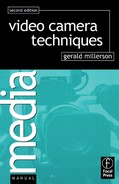Even quite simple situations can pose some surprisingly tricky problems.
How do you shoot subjects that are tall, round, long … with a camera that has a constant horizontal four-by-three picture shape?
If you do the obvious, and take an overall view of the subject, this will show its general form, but important details will probably not be clear. If you concentrate on the details, there is always the chance that your audience will not realize how these relate to the whole.
One major difficulty is that you often cannot get far enough away from a large subject, before other things nearby get in the way and spoil the shot. In some situations, even quite a small object in the foreground can obscure a large subject in the distance.
Although you may find that a wide-angle shot will cover the entire subject from a reasonable distance, it will probably distort its shape and proportions and give a very false idea of distances. This is very obvious when shooting upwards at skyscrapers. Paradoxically, the foreshortening and strong perspective can produce a very powerful arresting image; but if the picture’s purpose is to show structural information and proportions, it is likely to be less than successful.
One solution when shooting a large subject is to begin with an overall view. This long shot gives the audience an idea of its general form. Then take a series of closer shots showing its main features in some detail.
As an alternative, you might select a viewpoint looking along the subject, then pan over it slowly, or shoot it progressively in sections.
Where things are spread around, you may have some difficulty bringing them together in the same shot. Let’s consider a couple of people sitting at either end of a long table. Avoid panning to and fro between the subjects. This ‘hosepiping’ over empty space looks very crude. An oblique end-on shot (perhaps an over-shoulder view) is better, for it helps the audience to maintain their sense of direction. Otherwise the answer is to take a long shot, then rely on intercut individual close-ups.
Apart from deliberate effects (glare, flares, silhouettes) it is best to avoid shooting into lights. (It can ruin camera tubes!) Light shining straight into the lens tends to degrade the image, and affect exposure. To prevent lens flares, try extending the lens hood (sun shade), or raise the camera and tilt down.
The wrong shape
Many subjects do not fit the screen’s four by three format at all well. They are too tall, wide, long, or the wrong shape. Such subjects have to be shot in a wide view and then in localised segments.

Spread subjects
When subjects are spaced wide apart, you can often group them together in a well-balanced shot by using carefully selected viewpoints.

